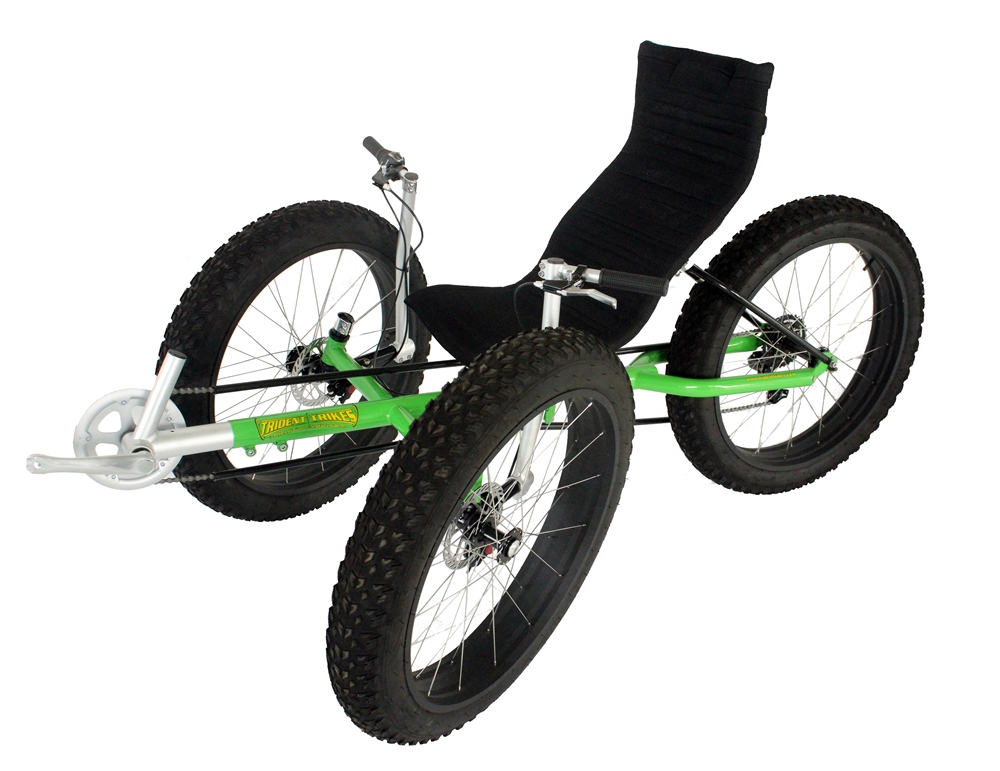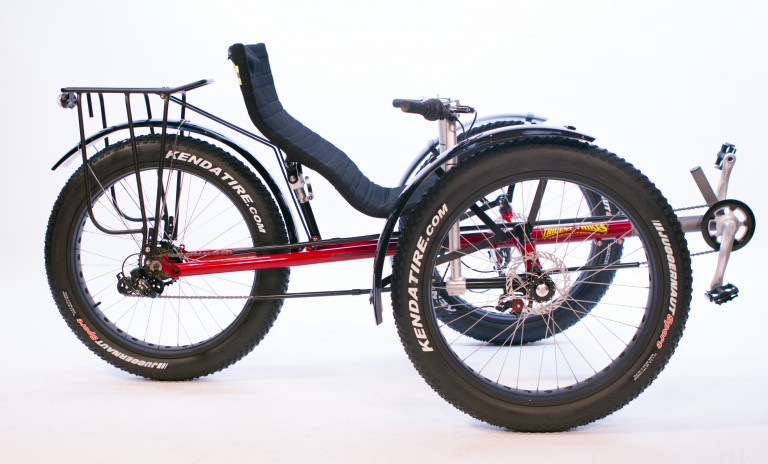Trident Terrain Review

Trident Terrain Posted on March 22, 2016, updated 4-03-23
The Trident Terrain will probably turn more heads than any other trike in the market. My son Nathan, who is 21 years old and is studying Mechanical engineering in college, got to be my riding partner for the day. We were very excited to try both the Trident Terrain and the Sun Seeker Fat Tad back to back. The trikes are both Fat tire trikes, but that is where the similarities end. Trident makes the Terrain in two wheel sizes: 20” Fat and 26” Fat and we tested the 26” wheel version. The Sun Seeker Fat Tad only comes with 20” Fat tires. Now, these trikes really are quite different.
Besides wheel size, the Sun Seeker comes with front and rear suspension and the frame is non-folding. During my ride with Nathan, we had the opportunity to switch trikes back and forth a number of times. I was excited to have him on the ride and see what he thought of the Trident Terrain vs the Sun Seeker Fat Tad.
Trident was smart in the design of the Terrain. Most of the design was borrowed from Trident’s other trike models. The frame is a modified Spike frame with a longer rear end to accommodate the 26” Fat tire and the handlebars are borrowed from the Trident Titan. Trident is known for having good quality trikes at a low price. I think they really do a good job at delivering just that. Trident has their trikes manufactured in China. Most everyone else manufactures in Taiwan, Germany, England or the USA. The people at Trident trikes are smart; they are keeping their overhead super low to keep their selling price low.
Frame: The Trident Terrain has a steel frame with a telescoping aluminum boom. The TIG welds are precise and consistent on the Terrain and better than you would expected on a trike in this price range. Trident uses direct steering on the Terrain which is simple and works just fine on this type of trike. The Trident Terrain can be folded very easily by removing the seat with the two quick release levers and then using the quick release lever on the hinge to fold the trike. The frame folds with the rear over top the front of the frame making it a traditional fold rather than a flat fold. A traditional fold means that you don’t have to remove your rack bags or panniers to fold the trike. I will have to say that the Trident Terrain folds easier than some trikes that costs almost triple the price. Trident gives the trike a 275 lbs weight capacity. There is also an optional extra-long boom for the Trident Terrain.
Paint: The paint is a powder coat that is applied generously and should last the life of the trike. It was smooth and had a nice shine. Personally, I think the green is awesome and just fits this aggressive looking trike perfectly.
Drivetrain: The drivetrain is a basic entry level Shimano seven speed paired with a Shimano twist type shifter. The Crankset is an alloy Crank with a 32 tooth Chain Ring. Trident offers an upgrade kit where the Terrain can be upgraded to a 21 speed. It all works well and goes good with this trike.
Brakes: Trident chose the Avid BB5 mechanical disc brake system on the Terrain and coupled them with locking alloy brake levers. I have no issue with the mechanical brakes that Avid offers; they are simple, reliable and easy to adjust.
Seat: The seat on the Trident Terrain is very adjustable. Its height can be adjusted from 20 7/8 to 22 7/8 inches and the seat angle can easily be adjusted with one quick release lever from 38 – 45 degrees. Trident’s new seat frame is made of aluminum and is much nicer than their older steel version. The new aluminum seat frame received some new shaping and fit my lower back and bottom well. The seat fabric is padded, breathable, and is well made. There is a reflective strip across the top of the seat and a nice zipper pocket in back. The seat is a bit wider and taller than most other trike brand seats which is a good thing. The Trident Terrain seat width measured 16 inches and the height measured 22 inches.
Ride: Both Nathan and I felt that the Trident Terrain was just a blast to ride. The super large fat tires just ate up the bumps and rolled over everything in our path. With the Fat tires, the ride became very comfortable. When I first heard that Trident was going to do a trike with 26” Fat tires, I thought there would be no way that thing would turn well. With such large tires, I thought that the tire would be rubbing on the seat all the time when turning, but that just did not happen. I was very impressed in how tight a circle you could turn on the Terrain. I also thought that the Fat tires would take a lot more energy to turn the trike and I was shocked that the steering had a much lighter feel than I expected.
We both preferred the seat at it lowest position and would have even liked it more a bit lower in relationship to the crank. This is just a personal adjustment and really just a bit different than most other trikes I ride. The Terrain crank is a bit lower in relationship to the seat than other trikes which is neither good nor bad, just different. Some people that have issues with, say, their feet going numb, will like how the crank is lower to seat. A slight negative to the lower crank to seat is it will cost you a little bit of power.
When we returned from our ride, we had some other people ride the Terrain as well to get some more opinions. Everyone agreed that the trike felt flexy and soft. I do believe there are a number of factors contributing to this feel. First are the tires which are at 10 Psi. The other trikers who rode the Trident Terrain usually keep their tires between 50 Psi and 100 Psi which change the ride dramatically. Second is that the frame is longer to compensate for the 26” fat tire. Third, there did seem to be some extra movement between the bottom seat quick release and the frame. All three things together contributed to the trike feeling a bit flexy but that is okay. Add a motor kit and this trike becomes one of my favorite trikes to ride hilly dirt road on.
Accessories: Trident’s neck rest is very well made and I like the extra-large pad. Trident’s rear rack is well made and a quality piece.
In Conclusion: You will not find a trike that will turn more heads than the Terrain. Simply, the Terrain is not very efficient but a real blast to ride.
Pros: A quality Fat trike that folds and a very reasonable price. Maximum coolness.
Cons: Big Fat tires with knobs take more energy to pedal. You will never win any races on this trike.
Pros:
- Good Quality for Low Cost
- Fat Tire
Cons:
- More Energy to use
- Not Very Fast
Best Place to Buy:
Your local bike shop or www.industrialbicycles.com


Terrain 20 Specs
| COMPONENTS | ||||||||||
| Cranks | Derailleurs | Shifters | Cassette | Front hubs | Chain | Rims | Spokes | Tires | Brakes | Brake Levers |
| 36T Single Ring Crankset 170 mm Crankarms | Shimano Tourney Rear | Shimano Revoshift | Shimano 14-34 7 Speed | Custom CNC Alloy Disc Hubs | KMC Z50 | Alloy Fat Tire 20 x 4.0 | SS 14g | 20 x 4.0 | Avid BB5 Disc Brakes (2) | Promax w/ Lock |
| DIMENSIONS | EXTRAS | |||||||||
| Track | Width | Wheelbase | Average Length (Varies) | Seat angle | Seat Height | Weight | Rider weight limit | Gear Inches | X-Seam Range | Safety Flag, Alloy Pedals |
| 31.5″ (80cm) | 35.3″ (90cm) | 43.3″ (1100 mm) | 74 3” (1885mm) | 38-45 degrees | 17 7/8″ to 19 7/8″ | 49.8 LBS (22.6 KG) | 275 Lbs | 19.8”-48.0” | 34 1/4″ to 47 3/8″ | INCLUDED |
Terrain 26 Specs
| COMPONENTS | ||||||||||
| Cranks | Derailleurs | Shifters | Cassette | Front hubs | Chain | Rims | Spokes | Tires | Brakes | Brake Levers |
| 32T Single Ring Crankset 165 mm Crankarms | Shimano Tourney Rear | Shimano Revoshift | Shimano 14-34 7 Speed | Custom CNC Alloy Disc Hubs | KMC X50 | Alloy Fat Tire 26 x 4.0 | SS 14g | Kenda Juggernaut 26 x 4.0 | Avid BB5 Disc Brakes (2) | Promax w/ Lock |
| DIMENSIONS | EXTRAS | |||||||||
| Track | Width | Wheelbase | Average Length (Varies) | Seat angle | Seat Height | Weight | Rider weight limit | Gear Inches | X-Seam Range | Safety Flag, Alloy Pedals |
| 31.5″ (80cm) | 35.3″ (90cm) | 44.5″ (1130 mm) | 77.3” (1965mm) | 38-45 degrees | 20 7/8″ to 22 7/8” | 52.8 LBS (23.5 KG) | 325 Lbs | 25.8”-62.8” | 34 1/4″ to 47 3/8″ | INCLUDED |